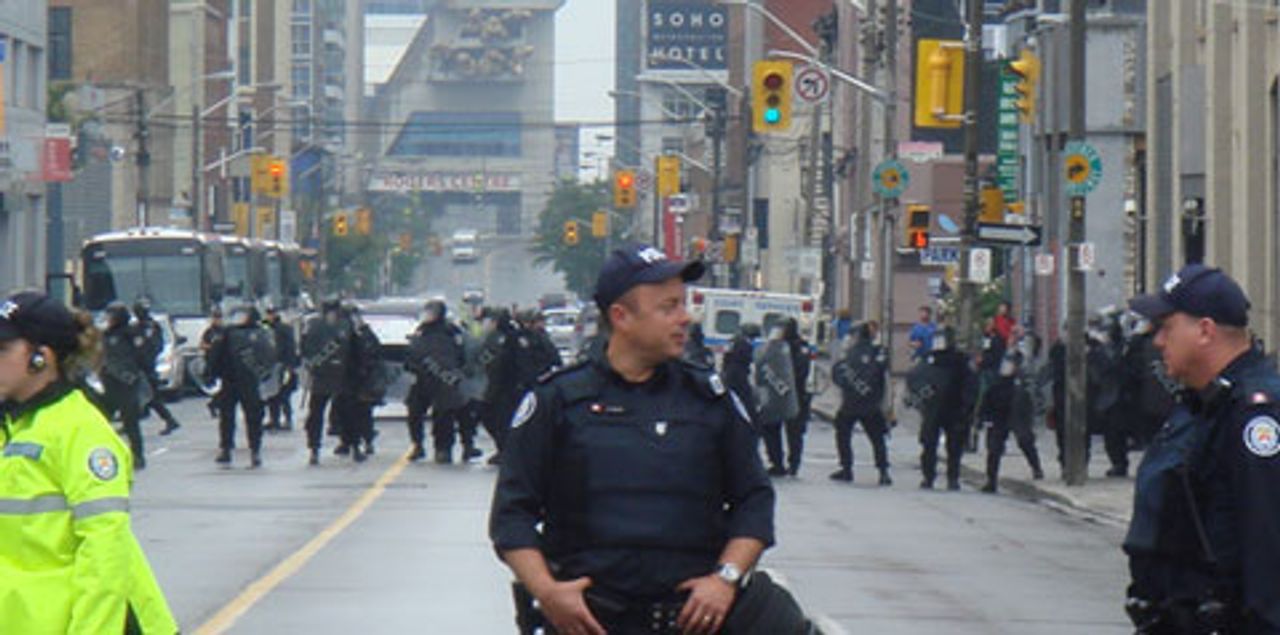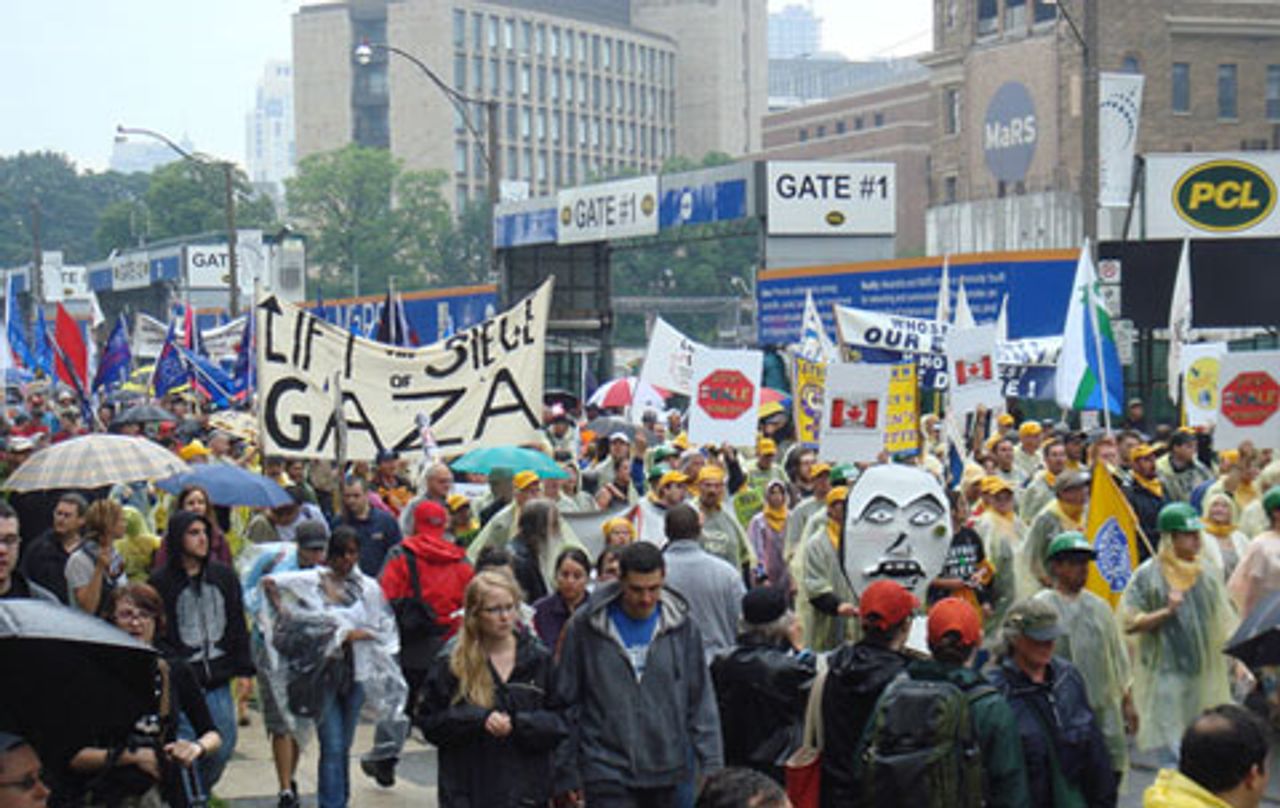 Riot police mobilized in downtown Toronto. Police would use tear gas, plastic bullets, and pepper spray
Riot police mobilized in downtown Toronto. Police would use tear gas, plastic bullets, and pepper sprayMore than seven thousand riot police, plain clothes officers and mounted patrols have been deployed in downtown Toronto in a naked violation of the democratic rights of not only the thousands of youth, trade unionists and social and environmental activists protesting the G20 summit, but of the entire Canadian population.
Over the past 48 hours, as leaders of the G20 governments moved to coordinate a massive global austerity program directed at the international working class, police—for the first time in Toronto’s history—deployed snatch squads, tear gas and rubber and plastic bullets to disperse groups of peaceful protestors attempting to march to the fenced in perimeter of the G20 venue.
By Sunday evening, over 600 people had been arrested, many in the so-called “free speech zone,” and detained in a make-shift holding pen on the grounds of a local film studio. Reports emerged of beatings and other violent actions against peaceful demonstrators.
Prime Minister Stephen Harper’s government has spent $1.2 billion to date for the security of the summit. The decision to hold the event in the heart of Canada’s largest city, not to mention the outrageous expenses incurred, has been roundly criticized by broad layers of the Canadian population faced with ever deeper cuts to their wages, pensions and social services.
In the week before the arrival of the G20 leaders, downtown Toronto exhibited all the hallmarks of a city under a state of siege. Six kilometres of fencing, topped with concertina wire and anchored in concrete encircled the “red zone”—the actual meeting area. Police checkpoints fanned out another kilometre from the convention location. Snipers were stationed on the city’s high rise rooftops. American Navy Seals patrolled the harbour.
Citizens in the vicinity were instructed to carry picture identification and expect curb-side interrogation. Canine units waited in the side-streets. Phalanxes of federal, provincial and municipal police stood at every corner buttressed by more mobile bicycle and horse patrols. Even truck drivers have been approached to act as “look-outs” for the police.
In addition, a thousand private security guards were deployed throughout the city’s adjacent financial and entertainment districts. Seventy-seven new closed circuit surveillance cameras monitored all movement on the streets. Water and sound cannon were moved into place. Police helicopters hovered constantly overhead. Security Service operatives swept through the hotels, and Canadian Armed Forces soldiers stood “on the ready” at “undisclosed locations”.
 A section of Saturday's 10,000-strong protest against the Toronto G20 summit
A section of Saturday's 10,000-strong protest against the Toronto G20 summitDespite the fact that several peaceful protests had proceeded through downtown streets over the past week, police raiding parties on Friday night made several “preventative arrests”, entering a house without showing a warrant to drag away demonstrators asleep on the floor.
On Saturday afternoon, about ten thousand demonstrators marched from Queens Park—the grounds of the provincial legislature and the police designated “free speech zone”—in a “People First” protest organized by the Canadian Labour Congress and the Ontario Federation of Labour.
In heavy rain, the march proceeded to within four blocks of a massive fenced perimeter that has sealed off Toronto’s Convention Center area for the past week. The march, however, was stopped on Queen Street by hundreds of heavily armed police. Whilst thousands of marchers, after being confined and “kettled” by the police on the narrow street, returned to the “free speech zone,” about two thousand stayed in place and insisted on their right to march.
During the stand-off, about 75 people—purported members of anarchist groups—broke away from the demonstrators and proceeded to spray paint graffiti and smash several dozen shop windows and bank branch ATM’s.
A police car was vandalized and set alight. A reporter noted that the gas cap for the car had been removed prior to the “Black Bloc’s” arrival. Shortly thereafter, at the corner of Bay and King—the centre of Canada’s financial district another police car was set ablaze.
It was at this time that local television stations, followed by CTV and the CBC—the country’s national news network—broke away from regular programming to breathlessly broadcast for hours on end “live” saturation coverage of events in the streets of the city. Video of the burning patrol car was then looped and re-looped into the country’s living rooms throughout the afternoon and into the night.
As always, police provocation may well have played a role in isolated acts of vandalism. The patrol car, torched by three or four individuals, was done in full view of a whole phalanx of riot policemen who stood idly by at the intersection. “Backup! Put your batons down”, shouted the attending police captain to the riot squad. No attempt was made to arrest the perpetrators. Fire extinguishers possessed by the police were not deployed. The Toronto Fire Department, which can respond to any downtown emergency within minutes, did not arrive for over an hour as camera teams gathered from all the networks.
As the small group of anarchists proceeded onto Yonge Street, Toronto’s main shopping district, to smash more windows, reporters noted that despite the mobilization of thousands of police officers, not one could be seen on the city’s busiest thoroughfare.
Shortly thereafter, the office of Prime Minister Stephen Harper—the man who has shut down parliament twice in the space of two years to circumvent opposition to his government—issued a statement. “Free speech is a principle of our democracy, but thugs that prompted violence earlier today represent in no way, shape or form the Canadian way of life”.
The incident spurred Police Chief Bill Blair to appear before the news media in the early evening to denounce violent demonstrators and to assure the population that the Integrated Security Force would bring the full force of the law down on the protest.
Throughout the rest of the night and into Sunday, police rampaged through the ranks of the various peaceful demonstrations marching in the downtown core. In the “free speech zone” protestors staging a sit-in were arrested en masse. Young people were clubbed and kicked. A CTV producer, Farzad Fatholahzad, covering the protest was arrested. En route to the detention centre on the prisoner’s bus, he reported that detainees were bruised and bleeding. One man, suffering from concussion, was slipping in and out of consciousness. All were denied medical attention. At the University of Toronto, seventy youth sleeping on a college lawn were assaulted and arrested.
At a Novotel hotel, that had been struck earlier in the week by members of the Hotel and Restaurant Employees union, a small group of protestors gathered in solidarity after midnight. Riot police violently broke up the peaceful demonstration.
Steve Paiken, a lead journalist for public television broadcaster TV Ontario, tweeted the following on-the-spot report: “(The Police) repeated they would arrest me if I didn’t leave. As I was escorted away… I saw two officers hold a journalist. The journalist identified himself as working for the Guardian. He talked too much and pissed the police off. Two officers held him. A third punched him in the stomach. Totally unnecessary. The man collapsed and the third officer drove his elbow into the man’s back. The demonstration on the Esplanade was peaceful. It was like an old sit-in. No one was aggressive and yet the riot squad moved in.”
On Sunday morning, police used tear gas and more plastic bullet to disperse friends of detainees who had gathered at the detention centre to greet released comrades. More violent arrests were made, including of legal advisers. Scores of detainees were released without any charge having been laid. They reported abysmal conditions in the cells. Most were denied water, toiletries and food for up to fourteen hours. A police officer referred to the previous night’s dragnet as a “catch and release” program.
Police and the government seized on the acts of vandalism to justify this brutal crackdown. The police released a statement Saturday night declaring, “We have never tried to curtail people’s rights to lawfully protest. All you have to do is turn on the TV and see what’s happening now. Police cars are getting torched, buildings are being vandalized, people are getting beat up (sic) and the so-called ‘intimidating’ police presence is essential to restoring order. That is the reality on the ground”.
Arrests and demonstrations in Toronto continue.
The World Socialist Web Site carries no brief for those groups of anarchists who, by engaging in vandalism, arm the agents of the state with the propaganda to intensify their attacks on the democratic rights. Their actions play directly into the hands of the very forces they claim to oppose. As observers of other international summits are well aware, the police do not hesitate to infiltrate agents-provaceteurs into their ranks in order to create the sort of mayhem that allows for the unleashing of police terror against the general population.
It would not be the first time such tactics were used to create the conditions for further curtailment of democratic rights. In 2007, at a North American leaders’ conference in Montebello, Quebec, police dressed as demonstrators were filmed carrying rocks and agitating amongst the crowd to join them in violent acts. And in 2001 at the Genoa, Italy, G8 conference, police agents were discovered to have instigated violence during protests.
The media plays its role through all-night saturation coverage, preempting virtually all network programming, highlighting the vandalous actions of some seventy-five people. In comparison, when a hundred thousand people demonstrated in Toronto against the American invasion of Iraq in 2003, the largest social movement of Canadians in the country’s history, it rated a minute long sound-bite on the nation’s networks.
